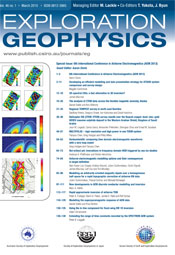
Exploration Geophysics
Volume 46 Number 1 2015
6th International Conference in Airborne Electromagnetics (AEM 2013)
This special issue of Exploration Geophysics comprises papers from the 6th International Conference in Airborne Electromagnetics (AEM 2013) held in South Africa, and showcases the latest ideas and advancements in the discipline of airborne electromagnetic geophysics.
EG14026Developing an efficient modelling and data presentation strategy for ATDEM system comparison and survey design
A proposal to simplify the display of ATDEM responses through the concept of a three-dimensional signal:noise nomo-volume is presented. It contains the signal:noise values of all system time channels and components for various target depths and conductances integrated into a single interactive three-dimensional image.
Spectral 3D approximations of the EM response can efficiently model vortex induction and current gathering for simple geological target geometries. This paper presents results of a spectral model fitting algorithm to automatically pick, locate and define a sulphide target from VTEM data at the Forrestania test range, Western Australia.
EG14006The analysis of ZTEM data across the Humble magnetic anomaly, Alaska
ZTEM data acquired across a magnetic anomaly of almost 30 000 nT were analysed for the presence of a magnetic gradient response and the effects from elevated magnetic susceptibilities. Modelling results indicate distortions in the conductivity structure recovered by 3D inversion when elevated magnetic susceptibility values are ignored during the inversion.
EG14022Regional TEMPEST survey in north-east Namibia
A regional scale low-cost TEMPEST208 survey in north-east Namibia has provided a geo-electric map of the area, including an indication of Kalahari cover thickness. While there are limitations in terms of detail and depth penetration, the results will assist explorers in selecting areas of shallow cover to reduce costs.
EG14028Helicopter EM (ZTEM–VTEM) survey results over the Nuqrah copper–lead–zinc–gold SEDEX massive sulphide deposit in the Western Arabian Shield, Kingdom of Saudi Arabia
Magnetic and electromagnetic (EM) results from both time-domain (VTEM and AFMAG (ZTEM) helicopter EM surveys are compared over the Nuqrah sedimentary exhalative (SEDEX) massive sulphide deposit in Saudi Arabia. The magnetic and EM data map major controlling structures but only the EM surveys are able to define the Nuqrah deposits.
EG14027MULTIPULSE – high resolution and high power in one TDEM system
The MULTIPULSE technology airborne TEM system transmits a high power pulse and low power pulse(s) (trapezoid or square) within a half-cycle. The high power pulse ensures good depth of exploration and the low power pulse allows higher near-surface resolution and better sensitivity to weak conductors as confirmed by field results.
EG14032Geobandwidth: comparing time domain electromagnetic waveforms with a wire loop model
The effect of time domain EM waveform, power and receiver sampling times are effectively compared for a wide range of time constants using a wire loop conductor model. Peak time constant and equivalent frequency can be determined analytically or numerically. Arbitrary waveforms can be modelled as a sum of simple short ramps.
EG14034Not extinct yet: innovations in frequency domain HEM triggered by sea ice studies
Operational use of frequency domain HEM for sea ice thickness mapping was the driving force for developing new purpose-designed systems. We present improvements in decreasing noise levels by one to two orders of magnitude, and implemented control signals to eliminate system drift. Ground tests and airborne field data confirmed the achievement of these goals.
EG14034 Abstract | EG14034 Full Text | EG14034PDF (3.5 MB) Open Access Article
EG14045Airborne electromagnetic modelling options and their consequences in target definition
Given the range of geological conditions under which airborne EM surveys are conducted, there is an expectation that 2D and 3D methods used to extract models of geological significance would be favoured over 1D inversion and transforms. We analyse data from the Musgrave province, South Australia, used for mineral and for hydro-geological prospecting.
EG13093Modelling an arbitrarily oriented magnetic dipole over a homogeneous half-space for a rapid topographic correction of airborne EM data
In mountainous areas, the airborne electromagnetic system can be at an angle with regard to the ground. We analyse how the data and the eddy current are affected in such a context. We also suggest a simple correction for the data and for the sensitivity function that reduces topography effects.
In the last 20 years, sphere and plate models have been integrated in parametric inversion programs which are used today for interactive interpretation of airborne electromagnetic surveys on powerful workstations. Different problems encountered in the implementation and application of these models are discussed and a case history from Abitibi, Canada, is presented.
EG14046Rapid approximate inversion of airborne TEM
Two algorithms have been developed to perform rapid approximate 3D inversion of airborne TEM. VPem1D performs 1D inversion at each data location above a 3D model. Interpretation of cover thickness is a natural application. VPem3D performs 3D inversion of resistive limit data. Conversion to resistive limits delivers a massive increase in speed. Both programs can operate on geological models to foster integrated interpretation.
EG14005Modelling the superparamagnetic response of AEM data
VTEM data flown at different system elevations across a known sulphide body and surface cover with elevated superparamagnetic (SPM) properties were analysed. The results indicate that SPM responses can be distinguished from deep conductor responses if the vertical AEM gradient is measured, with EM sensors being offset vertically by 2–40 m.
In conductive areas, the in-line component of an offset transmitter–receiver EM system can be more sensitive to the near-surface than the vertical component. Using estimated noise levels, this paper calculates the expected uncertainty on the inverted parameters of a bathymetry model and compares this to inversion results from field data.
EG14029Extending the range of time constants recorded by the SPECTREM AEM system
The Spectrem AEM transmitter has no off-time; secondary signals are recorded at the same time as the transmitter primary. By assuming the secondaries have decayed away by the last window, the signal value is used as an estimate of the primary. The result is underestimation of the secondary amplitudes if the target is highly conductive. This paper describes a method to compute a better estimate of the primary amplitude.

